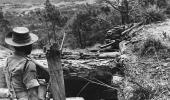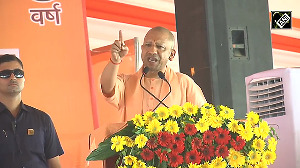It will never be possible to recreate an exact account of this epic battle to remember and honour other brave jawans, but one thing the nation will always do is to bow down their heads in respect and reverence at the war memorial at Chushul called The Rezang La War Memorial -- Ahir Dham.
A fascinating excerpt from Kulpreet Yadav's The Battle Of Rezang La.

When Major Shaitan Singh and the soldiers accompanying him were 400 yards from the company headquarters, an unseen MMG cut through their column. Major Shaitan Singh got hit by a burst of MMG fire in his abdomen.
Company Havildar Major Harphul Singh hooked the major's left arm and helped him move for 200 yards till they were safe.
Out of the twenty men from the platoon and eight from the company headquarters, only five survived.
As CHM Singh turned, he got a final glimpse of Lance Havildar Balbir Singh, the section commander, leading his three men in a bayonet charge into a mass of grey uniforms of Chinese soldiers.
Over the ear-splitting sound of enemy fire, Naik Ram Kumar ordered L/Nk Siri Ram and L/Nk Roshan Singh, 'Both of you disable your mortar and leave. Now!'
But the courageous soldiers replied, 'No, sir.'
Nk Ram Kumar persisted, 'There are just a few bombs remaining now. It would be of no purpose to stay any longer.'
'Sir, we will not leave you alone here.' The loyal soldiers refused to leave without Nk Ram Kumar.
By now, Nk Ram Kumar had been riddled with many bullets and his nose had been blasted away by shrapnel.
Tragically, as the two soldiers were loading a new round, a burst of MMG fire stopped them midway and both died. Now, out of ten soldiers who were present in the mortar section at the beginning, only one was alive -- Nk Ram Kumar.
By any standard, it was an unequal fight, but Havildar Phul Singh and Sepoy Nihal Singh were continuously firing at the flaming MMGs of the Chinese and the enemy soldiers who were edging closer with every passing second.
Hav. Phul Singh managed to neutralize one of the guns briefly, but their location was hit by a 75 mm anti-tank rocket soon after. After this, Hav. Phul Singh stopped firing as he was fatally wounded by shrapnel.
Even as Hav Phul Singh, one of the most respected NCOs of the unit, lay next to him without breathing, Sep. Nihal Singh kept on firing. Within a few minutes, both his hands were shot through by an MMG bullet and the LMG fell out of his hands.
Sep. Nihal Singh lay down and tried to dismantle his LMG, as ordered by the company commander, but his hands were bleeding heavily and refused to obey the commands of his brain. He was helpless, lying there among the martyred soldiers of his company.
When there was no fire from the Indian side for a few minutes, a large number of Chinese soldiers descended on the LMG's position.
Sep. Nihal Singh was finally taken prisoner.
The Chinese soldier kicked the LMG out of Nihal Singh's reach and asked him in Hindi, 'Tumhara naam kya hai? (What is your name?)'
Nihal Singh, who was in a lot of pain as he was bleeding from both his arms, replied, 'Nihal Singh.'
The Chinese asked his next question, 'Tumhare CO ka kya naam hai? (What is your CO's name?)'
'No,' shouted Sep Nihal Singh.
The Chinese took him away, but the courageous sepoy would escape from Chinese custody a day later.
But the Chinese had no idea that the Charlie Company had not given up yet. There was one man still standing.

The time was 0915 hours and Nk Ram Kumar had by now disabled his mortar. He was contemplating his next course of action when he saw the Chinese soldiers less than 20 yards away. Right behind him was the reverse slope and to escape, all he had to do was roll down. He had done his job well. Only seven bombs out of the 1,000 that his section had prepared were remaining.
His entire section had been martyred. One thing he would certainly not do was to even think about returning back to the battalion. This was where his buddies had laid down their lives and this was where he would lay down his. But not before he could inflict further damage upon the Chinese.
Nk Ram Kumar had no personal weapon with him and therefore, he moved towards his left unseen and got inside the damaged company headquarters. Inside, he found a rifle. He cocked it and sat down waiting, staring at the entrance.
Nk Ram Kumar was badly wounded with as many as nine bullet marks on him by now and his nose had been blasted away. In the middle of his face all that remained were two bloodied holes. His clothes were soaked in blood. As he waited, looking at the entrance through the rifle's sight, his eyes were heavy and he was barely breathing.
He killed the first enemy soldier who popped his head inside with a single shot. That's when grenades were thrown inside the company headquarters through every hole. Nk Ram Kumar set his rifle aside and lay down in a foetal position. That's when he lost consciousness. The Chinese were, however, still scared and, seconds later, they set the company headquarters on fire.
Due to the intense heat, Nk Ram Kumar woke up with a start. He must have been knocked out for just a few minutes. Dazed, he looked around and realized that his clothes were on fire and the company headquarters was full of smoke. He was unable to breathe. He found an opening and with his breathing laboured due to exhaustion and lack of oxygen, he escaped through it.
Nk Ram Kumar crawled for some distance before rolling down the hill. On the way, he lost consciousness again.
Finally, the next day, he limped and somehow made it to the battalion headquarters.

By now, Maj Shaitan Singh had been carried to a lower location through a gully with the support of CHM Harphul Singh and four others including Sep. Ram Chander. The company commander was in a lot of pain and he said he wanted to sit down.
Then he said, 'Please open my belt. I'm in a lot of pain.'
The batman bent forward and when he put his hand inside, he realized that the burst of bullets had done a lot of damage. If he removed the belt, the internal bleeding would increase and the intestines would come out. He looked at the CHM.
CHM Harphul Singh said, 'Sir, just some more distance. We need to take you to a hospital.'
By this time, the gallant company commander had realized that he would not survive. He said, 'I want you to leave me here and go to the battalion headquarters. Report to the CO how bravely our company fought.'
The jawans persisted, but the major urged them, 'Go fast, save yourselves. The enemy can come here any time.'

The jawans had tears in their eyes. Finally, after helping their company commander to rest against a boulder, the jawans reluctantly left. Maj Shaitan Singh had given his personal pistol to Sep. Mamchand to deposit it with the battalion quartermaster so that it would not fall into the enemy's hands.
Maj Shaitan Singh was hardly breathing when the jawans left him to follow his last order -- to save their lives and to report to the CO how the Charlie Company fought the battle. The Indian Army would find him at the same spot three months later, his whole body covered in snow, except his face.
The real tragedy that befell the brave jawans of the Charlie Company was when the accounts of the handful who survived were not accepted by the officers. The final orders of Maj Shaitan Singh were received with a lot of circumspection and were rejected.
Sep Ram Chander says when he insisted to the officers that what he and the others were saying was the truth and the Charlie Company had indeed fought a brave battle, he was asked to shut up or face a court martial for being a liar.
Consequently, the last stand of the Charlie Company was forgotten by the army and the nation. But the gods had other plans. Because what was to follow three months later would silence even the harshest of critics within the army.
In the first week of February 1963, a Ladakhi shepherd happened to visit Rezang La. The temperature was still fluctuating between minus 10 and minus 20 degrees Celsius and it was too early for the predators to start hunting for food. The entire moonscape of Rezang La was as white and as frigid as it was on the morning of the battle on 18 November 1962.
This shepherd was the first Indian to witness the closing stages of the battle turned into a frozen tableau. Right in front of his eyes were the frozen bodies of the Indian jawans still standing in their trenches with their weapons pointed towards the east.
The information reached the headquarters in Delhi in no time and a search party was organized. Several officers and jawans of the Indian Army, including Brigadier T N Raina, and Red Cross representatives were part of this search party that trekked to Rezang La from the base of Rezang La Pass, where once the Charlie Company's administrative base was located.

One of the members of this search party was Captain Kishori Lal. In an essay published in The Gods of Valour, he records his first impressions on arrival at Rezang La as follows:
'We reached Rezang La on 10 February 1963. There we saw the brave sons of mother Bharat sleeping in eternal sleep. We saw there was a heavy bombardment that the Chinese had done to wipe them out. There were deep pits all around. We picked up blind bombs and weighed them. Most of them were over 80 pounds. Each body of our valiant soldiers there had over thirty - thirty-five bullet wounds. As many as forty seven bullets had sunk into Jemadar (Naib Subedar) Hari Ram's body. On one bunker shield, we counted 759 bullet holes.'
The following excerpt from the official account of the Kumaon Regiment of the Indian Army provides more details:
'No bunker in Rezang La was found intact, corrugated iron sheets were found in bits, the ballies (wooden poles/logs used for making temporary shelters) had been reduced to matchwood sticks, and the sandbags were just shreds. But there was no sign of panic or withdrawal. Every single jawan was found dead in his trench; each had several bullets or splinter wounds, still holding their weapons; broken light machine guns/rifles bore witness to the intensity of the enemy fire. Jemadar (Naib Subedar) Hari Ram was found with a bandage on his head. He had apparently tied it in a hurry while rushing from one of his sections to another and was killed there: the body, when received, was still in crouching position.'
The rescuers who visited Rezang La on 10 February 1963 were speechless.
Brig Raina called his subordinate from the search party and said, 'I want everything to be photographed. After that, make a list of the martyred jawans you can identify.'
'Yes, sir.'
'We will cremate these bahadur jawans today itself.'
'Sir, here?'
'Yes, right here. This land belongs to us because of these brave patriots. And there should be a memorial here for every Indian to visit and pay his respects.'
'Yes, sir.'

That evening, the bodies of ninety-six soldiers of the Charlie Company were recovered from Rezang La and they were cremated with full military honours amid the chanting of Vedic mantras. Brig Raina lit the combined funeral pyre of the soldiers with his own hands.
Those present recall that everyone had tears in their eyes. Brig Raina, who would later rise to become the chief of army staff, got so emotional that he had to remove his prosthetic eye for relief.
The army had initially refused to accept the account of the survivors, who were merely following the last order of their commander, Maj Shaitan Singh. But mother nature had preserved the last stand of the brave soldiers as it is.
There were no more doubts in the mind of the senior officers now. There were no more threats about court martials. They had seen it for themselves and realized that every word that the survivors had spoken was true.
Maj. Shaitan Singh's body was found at the same spot where his loyal soldiers had left him. He was still resting against the boulder, his entire body except his face covered in snow.
It seemed as if the brave officer, outstanding tactician and admired leader, was taking a bit of rest before getting up and thundering with his command to destroy the Chinese.
It will never be possible to recreate an exact account of this epic battle to remember and honour other brave jawans, but one thing that the nation will always do is to bow down their heads in respect and reverence at the war memorial at Chushul called The Rezang La War Memorial -- Ahir Dham.
Excerpted from The Battle Of Rezang La by Kulpreet Yadav, with the kind permission of the publishers, Penguin Random House India.
Feature Presentation: Aslam Hunani/Rediff.com











 © 2025
© 2025